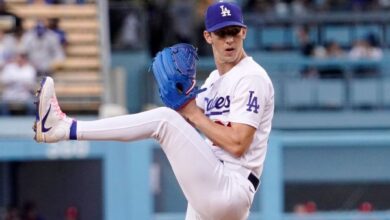Deep league starting pitcher targets for the very end of your fantasy baseball draft

When we were looking for breakout young pitchers, we looked for good stuff with fastball (or slider command) — we were being greedy. Now that we are looking for end-game, dollar-in-the-auction, last pitcher types, we can soften the requirements a little. Maybe the stuff isn’t quite as good, or the command, or their opportunity on the depth chart is more obscured. You can’t get everything you want once 300 players have already been taken in your fantasy draft. At that point, you’re just looking at something to be positive about.
With these six pitchers, there’s more than one thing that speaks in their favor. None of them is lower than sixth on their starting pitcher depth charts, and all of them have at least one good out pitch, and at least one pitch they can command. They’re all cheap. That’s enough to take a chance on them.
We’ve listed their average draft position in drafts (ADP), as well as their projected ERA and strikeout rates using Jordan Rosenblum’s projections, which are powered by Stuff+. Stuff+ uses the physical characteristics of a pitch to assess its quality. Last year, this effort netted Braxton Garrett, Mitch Keller, and Tyler Wells, which isn’t bad for the bargain bin.
Louie Varland, Minnesota Twins
ADP: ~300
ppERA: 4.26
ppK%: 21.6 percent
The arsenal seems like it’s ready to rock. He’s got a 95 mph four-seamer with good ride (108 Stuff+) that he can command (111 Location+) as the base. The slider is average-ish (101 Stuff+) with good sweep and again he commands it well (105 Location+). The 89 mph cutter is only OK by stuff (94 Stuff+) but, and there’s a theme here, he can command it well (106 Location+). Take a look, he’s good at avoiding the heart of the zone and also seems to have a couple of locations he can throw to with ease for each of these primary pitches.

Unfortunately, his changeup isn’t really good by either measure, as he hung it and it was below-average by movement and velocity. Hitters slugged .599 off of that pitch.
With all that command, maybe it doesn’t matter. With any more sweep on the slider, he could basically feature the cutter more against lefties and the slider more against righties and be a 2.5-pitch pitcher to each hand. His fastball is the kind that works to both hands. Without any improvement in the slider, he does have the risk of sliding into a relief role, especially since Simeon Woods-Richardson or David Festa (or even a healthy Anthony Desclafani) could push him for the fifth-starter role in Minnesota.
But Varland has the best fastball of that group. And when the slider looks like this and has 12 inches of horizontal movement, it looks like a real weapon.
There’s enough of an arsenal and opportunity to take a shot.
Dean Kremer, Baltimore Orioles
ADP: 337
ppERA: 4.62
ppK%: 20 percent
Speaking of arsenals, Kremer’s got a wide one. He threw six pitches at least 100 times last season. The quality of each … well, that’s TBD, as you can tell from the mediocre projections. Check out the full appraisal from the model:
| Pitch | Number | Stuff+ | Location+ | Pitching+ |
|---|---|---|---|---|
|
4-Seam |
1081 |
98.7 |
102.9 |
103.1 |
|
Cutter |
699 |
100.2 |
104.8 |
99.6 |
|
Sinker |
426 |
81.9 |
105.7 |
98.8 |
|
Changeup |
357 |
88.4 |
91.4 |
92.8 |
|
Curveball |
260 |
91.3 |
97.9 |
99.6 |
|
Sweeper |
100 |
126.0 |
95.0 |
104.0 |
He has the makings of a three breaking ball approach, it looks like. A little more command of the sweeper, a little more improvement of the curveball’s stuff, and he can throw two fastballs and three breaking balls with above-average command of three or four of them. The fact that he throws so many pitches alone makes him an interesting candidate for improvement.
But which pitch will take the step forward?
He threw his curveball with the best combination of velocity and drop in September, but batters slugged .889 that month off the pitch. He threw the cutter more throughout the season and it got good results all the way through, but that’s already a foundational pitch for him. He threw his changeup harder throughout the season, and the results were pretty good, so maybe the model is missing something there. He stopped throwing the sweeper in May, but what if he brought that back?
Kremer obviously has a feel for a large group of pitches, and decent command of many of them. It might not be exactly clear which pitch he’ll figure out, but there are a couple of different ways he could improve.
Keaton Winn, San Francisco Giants
ADP: 423
ppERA: 4.04
ppK%: 21 percent
Only one pitcher in all of baseball last year (minimum 40 innings) threw their splitter more often than half the time. His name was Keaton Winn.
“When I was coming back from Tommy John surgery, I had to stop throwing the breaking ball,” he said when I asked about learning the split-finger, “so I just threw splitter after splitter.”
Stuff+ loves the pitch (136 Stuff+) and even though he threw it so often, batters didn’t love it (.221 batting average, .347 slugging). In the city where Kevin Gausman just decided to throw splitter after splitter and broke out, could Winn follow suit?
Survey says yes (especially considering the small sample slider looked fine too — 121 Stuff+). And the Giants will probably need him, even if they sign a new pitcher because he’s third or fourth on the depth chart behind Logan Webb, Kyle Harrison and maybe Jordan Hicks. By the time Alex Cobb and Robbie Ray are back, he might have solidified his place on the big-league roster.
Worst case, Winn provides some early-season innings in good matchups in one of the best pitcher’s parks in the league.
Joe Boyle, Oakland Athletics
ADP: 434
ppERA: 4.04
ppK%: 24.9 percent
Here’s another pitcher in a pitcher’s park with a decent place on the depth chart. That’s where the similarities end. Boyle is all stuff and bluster, with no command. He’s gotten command grades from scouts as low as 20 on the 20-80 scale.
You can’t ignore the good. All three of his pitches are rated as at least one standard deviation above the mean by Stuff+, with his slider being two standard deviations better. His fastball, which has a couple of inches more ride than average, sat 98 last season and ranks with some of the best in the game by that stat.
It’s probably a great fastball by things like movement and velocity. He also commands it worse than anyone above him on the list, so the best news could be that he actually placed his slider in above-average locations. He might have a weapon he can use when he’s behind in the count.
Would it be better if Boyle hadn’t walked 19 percent of the batters he faced in the minor leagues, or was able to place his fastball better? Yes. Is it a good sign that he was able to locate the slider in a small sample? Maybe. Usually, you want a larger sample for command data.
This is a bet on the stuff, the park, and the opportunity more than being sure that the command is better than the minor-league track record suggests.
Randy Vázquez, San Diego Padres
ADP: 573
ppERA: 4.51
ppK%: 19.3 percent
First and foremost, there’s opportunity in San Diego. Behind Joe Musgrove, Yu Darvish, and Michael King lies two to three open spots that could be filled by Vázquez, Pedro Avila, knuckleballer Matt Waldron, the young Drew Thorpe, and fellow ex-Yankee Jhony Brito. The bet here is that Vázquez and Brito will take the lion’s share of those innings due to their wide arsenals.
Vázquez threw six pitches at least 50 times last year. The curve and the sweeper rated as above-average by Stuff+, which also lined up with the results, and batters slugged around .300 on those pitches combined. The changeup was near average but got great results (.100 batting average, .300 slugging). That’s the foundation: usable secondary pitches that he can use for called or swinging strikes.
The hard pitches — his four-seam, sinker, and cutter — were his most-thrown pitches, and they didn’t rank that well by Stuff+, but he got decent results on the four-seamer and sinker, probably because he locates them well. Vázquez was one of 55 starters last year to throw four pitches (thrown at least 50 times) to above-average locations. Commanding sub-optimal hard stuff to get to better secondaries is a tried-and-true approach.
One of the keys to a potential breakout may be that cutter.
Vázquez threw it harder earlier in the season, and softer with more break late in the season, and it didn’t matter either way. Batters slugged .650 on the pitch for the season. Maybe it just has to go. Sometimes improvement comes from slimming a wide arsenal. By September, he was already 60 percent four-seamers, changeups and curves. Maybe even fewer cutters is his pathway forward.
Here’s a little love for Jhony Brito (557 ADP, 4.46 ppERA, 17.5 percent ppK%), too. His out pitch (the curveball) might be better than any of those thrown by Vázquez, and his sinker is a better hard pitch than any of those thrown by his teammate, but his four-seam and slider are worse. Pick your champion — if they pitch well, they’ll get all the innings they want.
Cody Bradford, Texas Rangers
ADP: 724
ppERA: 4.78
ppK%: 19.1 percent
After 700 players have been picked, you’re really hunting for anything that might be interesting. Pitchers I’ve taken after pick 657 in the couple of deep drafts I’ve taken so far include Adrian Morejon (4.04 ppERA, 22.9 percent ppK%, just a bet on stuff in the rotation or the bullpen), Spencer Turnbull (4.57 ppERA, 19.5 percent ppK%, maybe he’s useful if there’s an injury on the Phillies), Ben Brown (a Boyle-esque pitcher who might get a chance in the Cubs rotation), and Connor Phillips (4.65 ppERA, 24.1 percent ppK%, also a poor-command, high-stuff guy on the Reds). Perhaps I should’ve taken Bradford instead of the guys with control problems.
The Rangers lefty only throws 90 mph, but as you might imagine with that velocity, he commands his pitches well. The four-seam, the slider, the change, the curve, all of them had above-average locations. But it isn’t fair to say he has no stuff. The four-seamer has above-average ride and horizontal movement, and though the change isn’t a standout vertically, its horizontal movement is enough to make it above average. Batters only slugged .283 off the pitch last year.
The key for him to do any better is to improve the breaking balls, which were terrible by Stuff+ (70 for the slider and 45(!) for the curve) as well as results (.800+ slugging). If he can’t, maybe he could do a 50/50 approach with the four-seam and changeup. He has the command to make it work. He will also have plenty of opportunity early in the season in Texas, where he could easily be the fifth starter in April, when Max Scherzer, Jacob deGrom and Tyler Mahle will all still be hurt.
Or just take a couple of relievers at the end of your draft, there’s often better pickings in that group when the player pool has been decimated this far.
(Photo of Louie Varland: Matt Blewett / USA Today)



